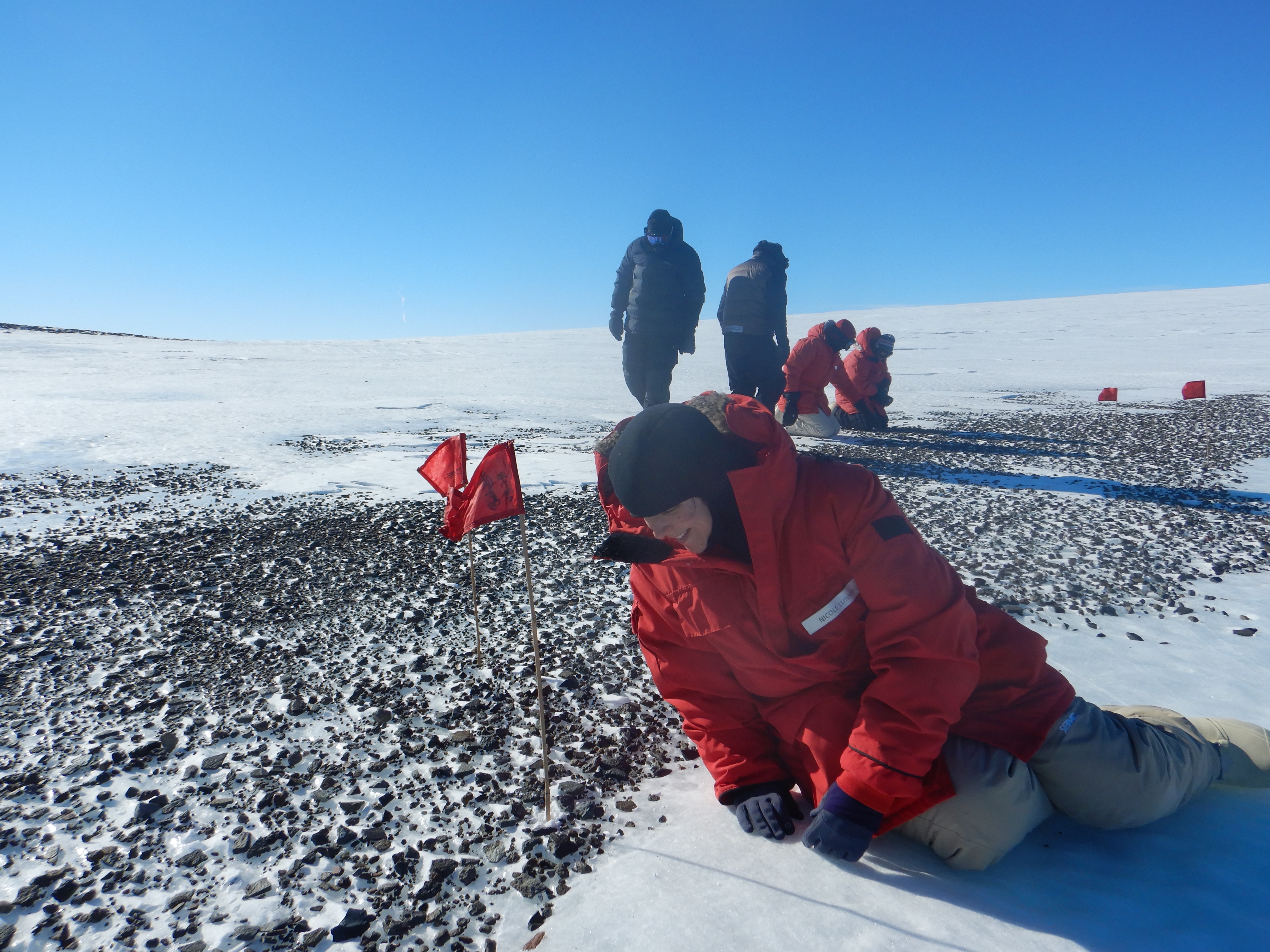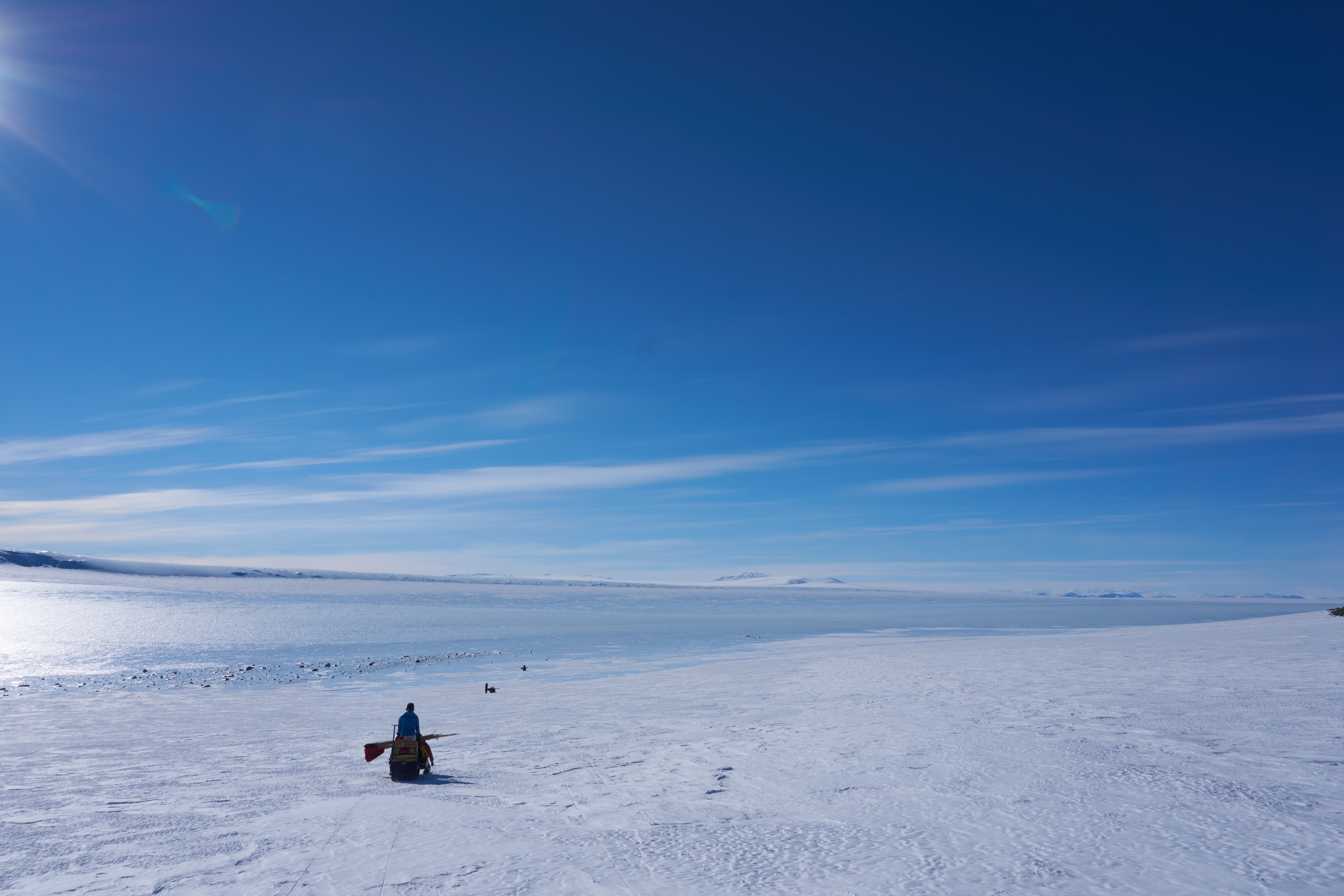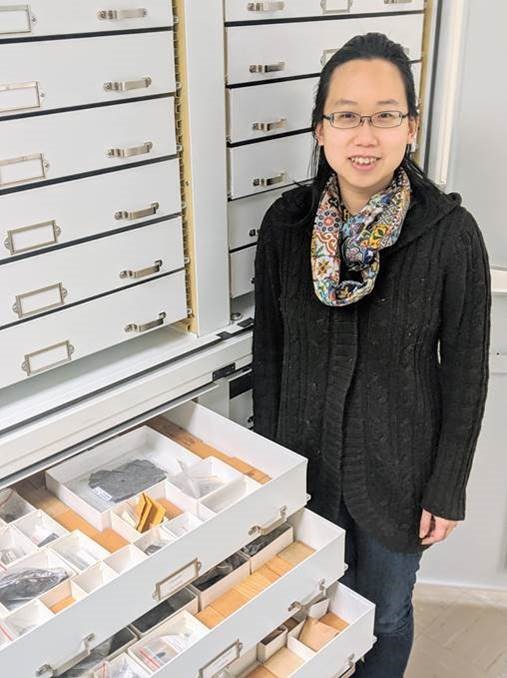Program News
Curator Comments
Kevin Righter, NASA-JSC
The Spring 2020 Antarctic Meteorite Newsletter features the announcement of 391 new meteorites from the Dominion Range (DOM), Elephant Moraine (EET), Grosvenor Mountains (GRO), Nodtvedt Nunataks (NOD), Mt. Prestrud (PRE), and Devil’s Glacier (DEV). Newly available meteorites include 2 lunar breccias (*likely paired with DOM 18262 from the Fall 2019 newsletter), an acapulcoite, brecciated eucrite, EH3 chondrite, CO3 and CK5 chondrites, and an L6 chondrite with a wadsleyite–bearing shock melt vein. This is the first report of occurrence of large discrete wadsleyite grains in a US Antarctic meteorite; smaller grains were found interspersed with ringwoodite in ALH 78003 (Ohtani et al., 2006). The wadsleyite and ringwoodite grains in GRO 17151 are optically distinct and clearly identifiable by their green and blue–purplish color, respectively. We also provide a summary of the 2019–20 ANSMET field season, the Smithsonian Report, and re–classifications of several chondrites.
Bibliography
Our online bibliography of peer–reviewed papers reporting data on samples from our collection, was updated in January with 54 new papers mostly from 2018. There are now >1600 papers compiled in the bibliography.
Field photos
We have added numerous field photos to the collection webpage, including now all available field images from 1976–77 to 2006–07 ANSMET field teams. In brief, there are some years with only partial coverage and other years with no coverage, but seasons since 2001–02 timeframe are nearly complete coverage. A full description of the field images is available here:
https://curator.jsc.nasa.gov/antmet/collection_curation.cfm?section=fieldimages
There are more coming so keep checking for updates.
Reclassification of LAP 031275
LAP 031275 was announced as an R5 chondrite in the September 2006 newsletter. Subsequent studies have showed that it is more likely an R3.6 (Lunning et al., 2020). From their paper is taken the following passage which nicely summarizes the reasons why this meteorite can be reclassified as an R3.6 with some confidence:
“The broad range in olivine and pyroxene major element compositions is not consistent with previous classification of this chondrite as a petrologic type 5.
Type 5 chondrites are characterized by equilibrated olivine and pyroxene (i.e., homogeneous major element compositions). LAP 031275, excluding the melt clast, contains olivine with a range from Fa1 to Fa47 and average Fa32±13 and low-Ca (Wo0-1) pyroxene with a range of Fs3-30 and average Fs20±11.
Type 4 is characterized by homogenous olivine compositions; the coefficient of variation of the Fa-content of olivine in LAP 031275 is 39%.
In ordinary chondrites, coefficients with variation of 40–50% are associated with petrologic type 3.5 (Sears et al.1982). The chondrules in LAP 031275 consistently have recrystallized mesostases, which are generally more consistent with petrologic type 3.5–3.9 (Brearley and Jones 1998). The olivine (both in chondrules and matrices) in the host breccia consistently have <0.1 wt% Cr2O3, which is consistent with type 3.6–3.7 ordinary chondrites because ordinary chondrites with types <3.6 have chondrule olivine with Cr2O3 concentrations that extend to higher concentrations, up to 0.6 wt% Cr2O3 (Brearley and Jones 1998). LAP 031275 based on petrologic type scale developed for ordinary chondrites olivine Fa coefficient of variation suggested petrologic type 3.5, the recrystallized mesostasis suggested type 3.5–3.9, and the Cr2O3 concentrations in olivine are consistent with type 3.6–3.7. The petrologic type scheme for ordinary chondrites does not seem to map perfectly onto this R chondrite, but these features indicate a petrologic type for LAP 031275 that is near type 3.5 but also slightly above 3.5. Therefore, we suggest LAP031275 has a petrologic type 3.6, as well as being an apparently unbrecciated R3.6 chondrite.”
Brearley, A. J., & Jones, R. H. (1998). Planetary materials. Reviews in Mineralogy and Geochemistry, 36, 3–1.
Lunning, N. G., Bischoff, A., Gross, J., Patzek, M., Corrigan, C. M., & McCoy, T. J. (2020). Insights into the formation of silica–rich achondrites from impact melts in Rumuruti–type chondrites. Meteoritics & Planetary Science, 55(1), 130-148.
Sears, D. W., Grossman, J. N., & Melcher, C. L. (1982). Chemical and physical studies of type 3 chondrites. I- Metamorphism related studies of Antarctic and other type 3 ordinary chondrites. Geochimica et Cosmochimica Acta, 46(12), 2471-2481.
For the full newsletter and further information about the new meteorites, go to:
https://curator.jsc.nasa.gov/antmet/amn/amn.cfm#n431
ANSMET 2019-20 Field Season- Jim Karner
Our 2019-20 field season to the Davis Nunataks and Mount Ward (DW) just finished and resulted in 346 recovered meteorites. That total includes a few achondrites, several carbonaceous chondrites, and about four or five we’re unsure of what type they are- hopefully something awesome! This year’s team was led by ANSMET personnel Jim Karner, John Schutt, and Brian Rougeux, joined by ANSMET vets Cindy Evans and Marc Caffee, and filled out with newbies Lauren Angotti, Nicole Lunning, Emilie Dunham, and Alex Gerst.
Our goal before the start of this season was to complete search and recovery efforts at DW. We’d worked parts or all of six seasons there, and recovered close to 3000 meteorites from the site, but we still had some systematic sweeping to do and a few moraines to explore. But alas, all sorts of delays from the very start the season rendered that goal unachievable. First off, the main team was delayed in Christchurch, NZ for eleven days. Bad weather and poor runway conditions at McMurdo Station kept flights from reaching Antarctica, so the team patiently waited in NZ. The team finally got down to the ice on December 13 and a week later the groom team made it to DW. The groom team needed to plow and buff up the landing strip at DW for the Basler aircraft that would soon bring in the rest of the team. The strip was groomed and ready in about three days but then the Basler was unavailable (i.e., being used elsewhere), so the team was delayed again; this time they team waited patiently in McMurdo. The whole team eventually made it out to DW, and searching started in earnest on December 31. The team spent the next three weeks performing skidoo sweeps on the blue ice and foot-searching the moraines that surround the ice fields. The team found a surprising amount of meteorites in (newly?) exposed wind-rows on the blue ice near camp (Figure 1), and on the far reaches of blue ice north of Mt. Ward (Figure 2)- two areas that had not been previously searched.
The team continued search and recovery efforts until January 23, when lousy weather started up and pull–out efforts began; the whole team was out of the field by January 27. This year’s team made great strides towards completing efforts at DW in the limited field time they had. ANSMET plans on returning to DW next year, and hopefully we will finish up efforts DW then!

Figure 1. ANSMET’s Nicole Lunning spots a meteorite in a wind-row.

Figure 2. An ANSMET team member heads out to the vast fields of blue ice north of Mt. Ward.
Report from the Smithsonian
Cari Corrigan, Geologist (Dept. of Mineral Sci.)

Figure 3. Sophia Lee, our newest employee.
This newsletter reports 396 new classifications, including some interesting features in meteorites that we don’t usually see (check out the description of GRO 17151 for an example). Things are going a little better here at the Smithsonian than they were last year at this time when we had to condense our newsletter classification process into a 2 week period. While we usually do concentrate our efforts into the month or so before a newsletter is due to be published, it is always nice not to have to be in quite that big of a rush!
In personnel news, Chris Anders and Greg Polley, who were hired with collections funds awarded to Meteorites Collections Manager Julie Hoskin, have been with us since October 2018. Greg recently transitioned into a full time federal position serving all collections at the Museum (congrats to Greg!) but thankfully Chris is still here (and honing his thin section making skills among other very helpful skills!). Since these two contracts were renewed for a second year (with additional funds obtained by Julie), we were able to hire Sophia Lee to help us out in the Division of Meteorites, and we welcomed her on board just before the holidays.
You may recall from the last newsletter that we were recently awarded money to digitize each Antarctic meteorite's data pack and we are in the process of finalizing the organization of this very important archival endeavor.
